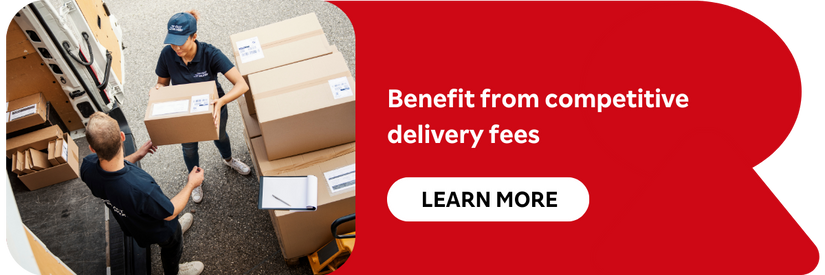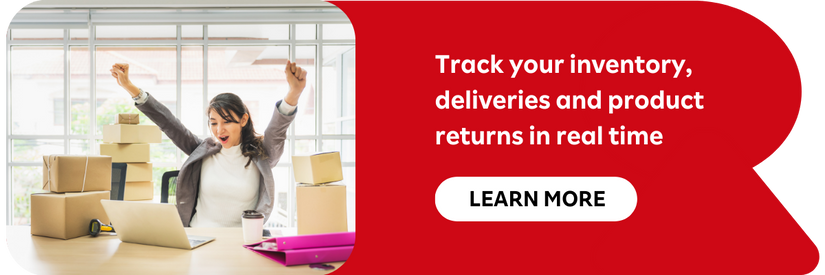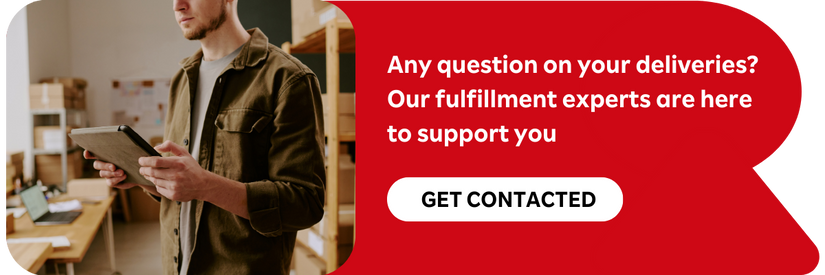How to choose your e-commerce logistics platform?
Did you know that nearly 67% of consumers have already abandoned a shopping cart? One of the main reasons: long delivery times. Today, Internet users expect delivery in less than 48 hours. As an online retailer, it can be difficult to meet these deadlines: handling, inventory management, parcel preparation, labeling, shipping, returns… each step can lengthen your delivery times. In the face of these challenges, e-commerce logistics platforms are the ideal solution. They enable you to centralize, speed up and make your supply chain more reliable, so you can better serve your customers and concentrate on selling.
What is an e-commerce logistics platform?
Unlike a traditional warehouse, where goods are stored for long periods, an e-commerce logistics platform is a transit and sorting facility, where goods are usually only held for a few hours.
Among its advantages:
- Smoother flows: optimized reception, sorting and dispatch to speed up deliveries.
- Adapted to last mile delivery (transporting parcels from the logistics center to the customer’s door): their proximity to final delivery zones saves real time.
- Management of seasonal peaks: ability to absorb large volumes (Black Friday, sales, Christmas).
- Reduced operating costs: pooled resources and optimized routes.
- Improved customer experience: shorter lead times and greater reliability.
Imagine a parcel that arrives, is scanned, sorted and immediately routed to the right loading dock for the final carrier. That’s the kind of speedy operation you can expect from a high-performance logistics center.
Essential criteria for choosing a logistics platform
Choosing the right e-commerce logistics platform is a strategic choice that has a direct impact on delivery times and delivery costs, profitability and customer satisfaction. Let’s take a look at the performance criteria you need to focus on.
Logistics platform cost
As an e-merchant, the cost of a logistics platform is often the number-one criterion. But it depends on several factors:
- Volume of orders processed.
- Duration and type of storage (short-term vs. long-term).
- Complexity of preparation (specific packaging, personalization, assembly).
- Additional services: returns management, kitting (grouping several items in a single parcel), logistics-related customer service.
Did you know?
With Rakuten Fulfillment Network (RFN), you benefit from competitive rates thanks to the pooling of carriers. By grouping your orders with those of other partner sellers, RFN organizes optimized rounds by destination: no truck leaves with a single parcel. This collective logistics approach avoids detours, limits empty runs and enables us to offer more advantageous delivery charges
Geographical location
The location of a logistics warehouse has a direct impact on delivery times and costs:
- Proximity to roads, railways, ports or airports. By choosing a well-positioned logistics hub, you benefit from faster distribution throughout the country.
- To sell abroad: a hub close to the target country or a warehouse located in the EU facilitates customs clearance and speeds up cross-border deliveries.
- Proximity to end-consumer markets (densely populated urban areas) reduces the “last mile” and carbon footprint.
Last mile” refers to the final delivery stage, between the warehouse and the customer’s address. This is generally the most complex and costly part of the logistics chain, involving numerous stops over short distances. Reducing this journey limits CO₂ emissions, transport costs and delivery times.
Storage capacity and scalability
The logistics platform you choose must also be able to grow with your business:
- Make sure it has sufficient storage space.
- Plan for scalability during periods of high demand (sales, holidays).
- Examine the flexibility of contracts to adapt surface areas or volumes according to the season.
Don’t lose sight of the fact that fast, reliable order picking is a key differentiator in the customer experience.
Integrated technologies and automation
A modern logistics platform relies on advanced technologies to streamline operations and ensure fast, reliable and cost-effective fulfillment.
- WMS (Warehouse Management System): this warehouse management system enables real-time control of stocks, locations, product movements and order preparation.
- Warehouse automation: the use of conveyors, autonomous mobile robots (AGVs – Automated Guided Vehicles) or robotic arms facilitates handling, goods movement and sorting, while reducing processing times.
- Enhanced traceability: thanks to barcode scanners, RFID (Radio Frequency Identification) tags and computer vision systems, every parcel is accurately tracked at every stage, reinforcing quality control and limiting errors.
- Predictive analysis and artificial intelligence: dedicated algorithms optimize picking, forecast peaks in activity, detect anomalies and manage logistics flows with a high degree of responsiveness.
Did you know? Thanks to Rakuten Fulfillment Network, you have access to a dashboard that enables you to monitor your stocks, orders and returns in real time
Infrastructure type and compliance
Not all products can be stored under the same conditions. An efficient logistics platform must be able to adapt to the specificities of each merchandise:
- Whether fragile, oversized, dangerous or fresh, certain goods require adapted infrastructures: temperature control, anti-shock devices or dedicated storage areas.
- To guarantee compliance, platforms must comply with recognized certifications such as ISO 9001, ISO 14001, or other sector-specific standards (food, cosmetics, health, etc.).
- High-value or sensitive products also require enhanced security features: video surveillance, access control, alarm systems and real-time tracking.
Note: logistics platforms operated by a 4PL (Fourth-Party Logistics) provider, such as Rakuten Fulfillment Network, also integrate strategic management of the entire supply chain, with an infrastructure designed to pilot different types of product flow, even complex ones.
Quality customer relations
The logistics platform must offer you a reliable partnership that integrates :
- Responsive teams and a logistics customer service that communicates.
- Contingency management (delays, damaged products, out-of-stock situations).
- Real-time tracking and reporting tools to help you manage your business effectively.
- High added-value services: kitting, personalization, returns management, parcel tracking, etc.
What are the steps involved in integrating a logistics platform?
Save time by targeting the right logistics platform and integrating it in 5 simple steps.
- Analyze your needs: order volume, product size, destinations, desired lead times and budget.
- Research and audit logistics service providers: technical capacity, references, certifications, geographical area.
- Contract negotiation: rates, SLA (Service Level Agreement), storage conditions, liability and returns.
- Technical integration: connection of systems, stock flow, WMS, compatibility with your store or marketplace.
- Progressive start-up: testing, monitoring of key indicators (costs, lead times, error rates), adjustments.
Have you considered Rakuten Fulfillment Network?
Entrusting your logistics to Rakuten Fulfillment Network frees up your time to concentrate on what really matters: developing your sales and promoting your brand. With its turnkey solution, RFN takes care of all operations: warehouse management, picking, packaging, shipping, returns and logistics transport. You benefit from competitive rates, advanced automation, real-time tracking via an intuitive dashboard, and enhanced visibility for your products on the Rakuten marketplace.
Choosing the right e-commerce logistics platform lays the foundations for sustainable growth. With Rakuten Fulfillment Network, you gain in reliability, performance… and peace of mind. Take back control of your business, and let RFN simplify everything else.


